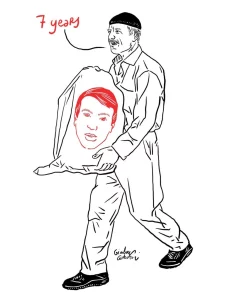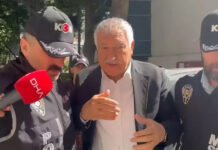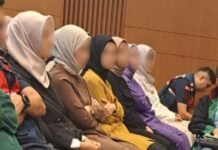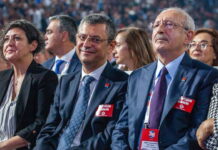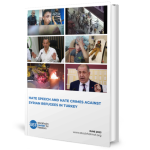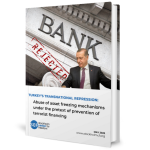Italian graphic artist Gianluca Costantini said in an interview with the Stockholm Center for Freedom that democracy in Turkey had been only a dream since the 2013 Gezi Park protests. He added that the situation had deteriorated further since an abortive putsch on July 15, 2016. “Human rights are violated on a daily basis in Turkey, especially since the failed coup in 2016,” he said.
As part of SCF’s interview series “Freedom Talks,” our researcher İrem Çörekçi spoke with Costantini about art and activism, human rights violations in Turkey and the possibility of using art to establish a more democratic world.
Costantini is a cartoonist, artist, graphic journalist and activist. He is known for drawing people whose rights have been violated around the world. Human rights violations in Turkey have been in his focus, and he has been accused of spreading terrorist propaganda by Turkey’s president, Recep Tayyip Erdoğan. Costantini has not been allowed to enter Turkey since a coup attempt on July 15, 2016, and his personal website where he publishes his work is banned in Turkey. However, all these restrictions have not stopped Costantini from using his pen to address human rights violations in Turkey. He has written about political prisoners in Turkey, children and babies behind bars in Turkish prisons, imprisoned and exiled journalists, activists, people killed or persecuted by Turkish authorities, minority rights in Turkey and much more.
Can you tell us about your work, your reasons for using your art as a tool to highlight human rights issues around the world?
I started drawing comics at the end of high school. Then I went to the Academy of Fine Arts in Ravenna, Italy. I started publishing illustrations and comics in my second year of study. To be honest, in the beginning the choice had to do with finances. I come from a working-class family and had very little money. Comics were the cheapest art that gave me many opportunities. All you need is a piece of paper and some black ink and you are good to go! During those years I started doing some very esthetic and decorative art, it was almost mystical research. I have recently collected a few things on my personal website, www.channeldraw.org.
After about 10 years, I was publishing and doing exhibitions, and things were going well for me. But then I felt the desire to leave the studio and tell the world what was going on in our world, but to do that I had to revolutionize the way I drew. One of my first drawings was of a radio journalist from the Philippines, Rowell Endrinal, who spoke out against local politicians and criminal gangs and was shot by two unknown assailants.
Your work revolves around human rights, and you dedicate your art to those who are unable to raise their voices due to oppression. Do you ever feel like this is a burden you have to carry as an artist?
I believe that artists are absolutely part of this world and therefore should bear responsibility. It’s not mandatory, but it’s not a burden, either. For me it was indeed a kind of liberation — I felt useful, and what I get in return is incredible.
Do you have contact with the families or loved ones of the people you draw? How do they respond to your work?
The drawings are often requested by their families and friends, and sometimes my drawings are a surprise to them. They always respond enthusiastically, like a message of love and help coming from afar. I frequently stay in contact with them for a long time, even after the situation has been resolved.
Since the Gezi Park protests in 2013, you have been drawing people whose rights have been violated by the authorities in Turkey. What do you think about where Turkey stands today in terms of human rights?
Human rights are violated on a daily basis in Turkey, especially since the failed coup in 2016. The Turkish government declared a state of emergency, and human rights violations were committed under the pretext of anti-terror measures. I think it is very difficult to live freely in Turkey and that democracy has become merely a dream.
Some of your work has been met with a very negative response from the Turkish public and authorities. You were censored in Turkey, and you were even banned from entering the country, but your drawings are still somehow reaching a Turkish audience. Can you tell us how all these things have affected your view of Turkey as an artist?
The Turkish government has not only censored me, it also accused me of terrorism, an easy way to ensure that I can no longer travel to Turkey. But this disgrace has only increased my attention and work about the country. I love Turkish people and have always felt at home in İstanbul. I hope things will change and we can all return to a more normal life. Above all, I want the charges against me to be dropped so I can go back to my second home. In the meantime, I will speak for those who cannot speak.
You draw about human rights violations and people who are oppressed in Turkey, regardless of their political or social views. That’s why you are criticized by people, even by journalists who do not agree with what you draw and accuse you of supporting outlawed organizations and criminals. What do you think about that?
In Turkey, taking sides against all forms of discrimination may seem impossible to people. I design for those who are deprived of their freedom of movement and expression. So I don’t care about his or her political or religious affiliation. I am interested in the individual. This often triggers outrageous accusations against me, such as being paid by Fethullah Gülen* or belonging to the Kurdistan Workers’ Party (PKK). But I would also defend members of the Turkish government if they were unjustly deprived of their freedom and the ability to defend themselves. I know, it’s a difficult matter.
All your work is equally important and remarkable, but I would like to know what you felt when you drew people who died in Turkish prisons?
They have had a great impact on me. It’s not easy to draw death, it’s a very intimate and personal situation, even if it’s in all the newspapers. But I think it should be reported that it was often very old or sick people who were abandoned in prison cells. But the Turkish government, although it was democratically elected, is behaving like a dictatorship. It really is no better than the Egyptian government, which is a military dictatorship.
How do you remain hopeful about the role of art in moving things in a good direction?
Art can change things; it can ask questions; and most importantly it can show what is going on in the world. Drawings can influence people positively and make them think. I love it when my drawings are seen on the street or when they are used all over the world for a cause. My work is only complete when people use it.
Art has always influenced society, and it is a naive vision that makes us believe that artists live in their own world. Our task — I would even say our duty — is precisely to try to change the rules thanks to a different vision. I am interested in an art that interacts with the community, an art that shares and does not impose. As far as I am concerned, art is a way to find oneself in discomfort, in conflict, in helping others, a way to work within the political and civil space. Art helps me to not look the other way.
* Fethullah Gülen is a religious scholar who inspired the faith-based Gülen movement. The Turkish government accused the movement of masterminding an abortive putsch on July 15, 2016. Gülen and the movement strongly deny involvement in the coup attempt or any terrorist activity.




